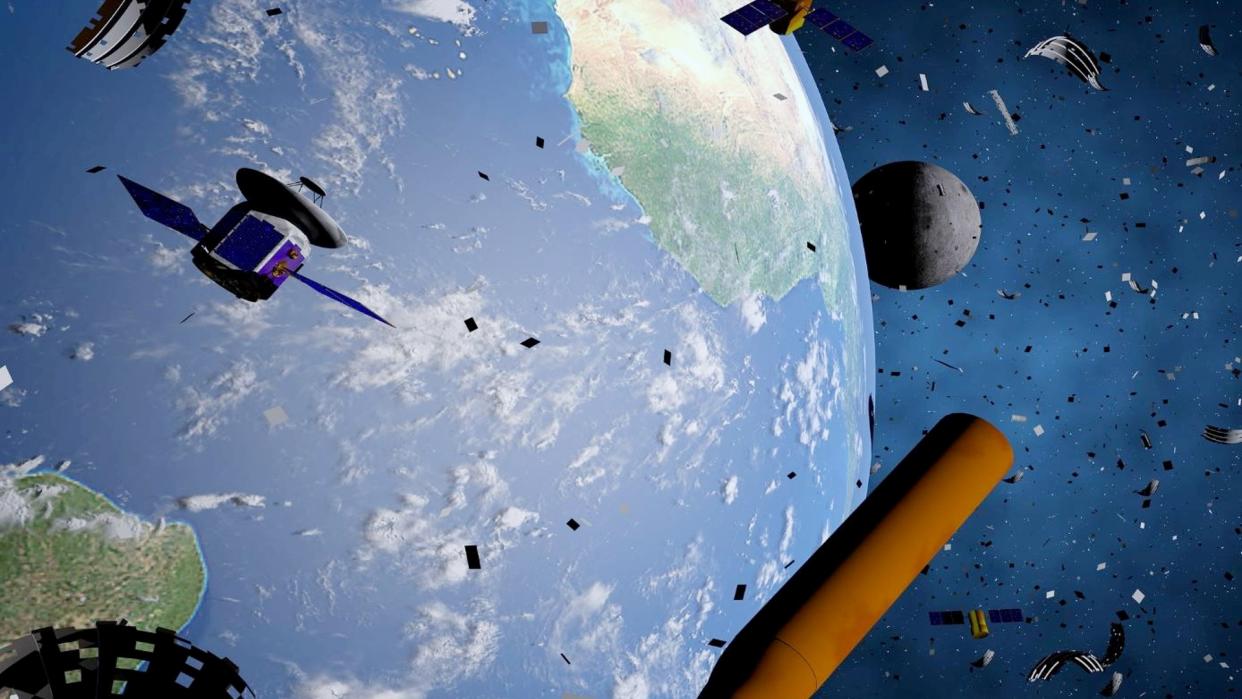Colliding space junk makes 'noise' that could be heard from Earth

Orbital smashups cause tiny pieces of space junk to emit signals that could be detected from Earth, a new study has found.
Space junk is a growing problem. As of November 2023, the world's space surveillance networks were tracking about 35,610 pieces of space debris larger than 4 inches (10 centimeters), according to the European Space Agency (ESA). That stuff is old satellites, used rocket stages and fragments spawned in orbital collisions and explosions.
These tracked objects are just the tip of the iceberg, however. About a million fragments between 0.4 inches and 4 inches (1 to 10 centimeters) in size are believed to hurtle around Earth at enormous speeds. The estimated number of fragments in orbit that are smaller than 0.4 inches is 130 million, according to ESA. These bits are mostly invisible to current debris-tracking methods, such as ground-based radars and optical telescopes. Yet they pack enough power to destroy or seriously damage operating satellites if they hit them.
A new method devised by researchers from the University of Michigan might help solve the problem.
Related: The rise of space tourism could affect Earth's climate in unforeseen ways, scientists worry
Using computer simulations, the researchers found that, when two objects collide at orbital speeds — enormous velocites that can approach 20,000 mph (30,000 kph) — they produce electrical bursts that can be spotted by Earth-based radio telescopes.
Space is huge, so even with all the clutter up there, things don't collide that often. But when there is a smashup, the tiny fragments that result are electrically charged. Whenever two of these charged fragments approach each other, they give off detectable sparks. The researchers compare this effect to the static electricity generated by rubbing certain types of materials against each other, like a balloon against your hair.
The researchers admit that these signals are short-lived and rather weak. Still, they think that with some extra work, the method could help track the so-far invisible, yet dangerous, tiny pieces of space debris that zoom around our planet.
"Right now, we detect space debris by looking for objects that reflect light or radar signals," Nilton Renno, a professor of climate, space sciences and aerospace engineering at the University of Michigan and the principal investigator behind the new mresearch, said in a statement. "The smaller the objects get, the harder it becomes to get sunlight or radar signals strong enough to detect them from the ground."
The team's modeling work suggests that the nature of the signal emitted by the charged debris pieces depends on the material the object is made of and the speed at which the collision happens. The detection of weaker signals may be obscured by the electrical noise generated by the detecting antennas. In addition to that, signals that are too weak may not be able to pass through Earth's atmosphere. But the researchers think that the method could eventually detect debris pieces as small as 0.04 inches (1 mm).
RELATED STORIES:
— 2 big pieces of space junk nearly collide in orbital 'bad neighborhood'
— Clearspace-1 space debris cleanup target in orbit just got struck by space debris
— Private company wants to clean up space junk with 'capture bags' in Earth orbit
The team plans to conduct further computer simulations and compare their results with real signals measured by NASA's Deep Space Network, a worldwide network of antennas that helps the U.S. space agency communicate with its farflung space probes.
They hope the nature of the signals could ultimately reveal a lot more about the debris fragments than just their position. The researchers think they might be able to deduce a fragment's shape and state from the measurements.
"We want to know if an object is hard or soft, because that will impact how it orbits and how damaging it can be," Akhavan-Tafti said.
The increase in orbital debris is a big concern for the space community. The quantity of orbital debris is growing, but so is the number of operational satellites. The odds of devastating collisions are therefore getting ever higher. Researchers fear that a few unfortunate orbital smashes could lead to an out-of-control situation called the Kessler Syndrome. Predicted in the late 1970s by NASA physicist Donald Kessler, the syndrome is an unstoppable cascade of collisions in which every new crash produces fragments that threaten other spacecraft. The syndrome only stops when there are no big objects left to be destroyed.
The study was presented at Second International Orbital Debris Conference in Sugar Land, Texas, on Tuesday (Dec. 5).

